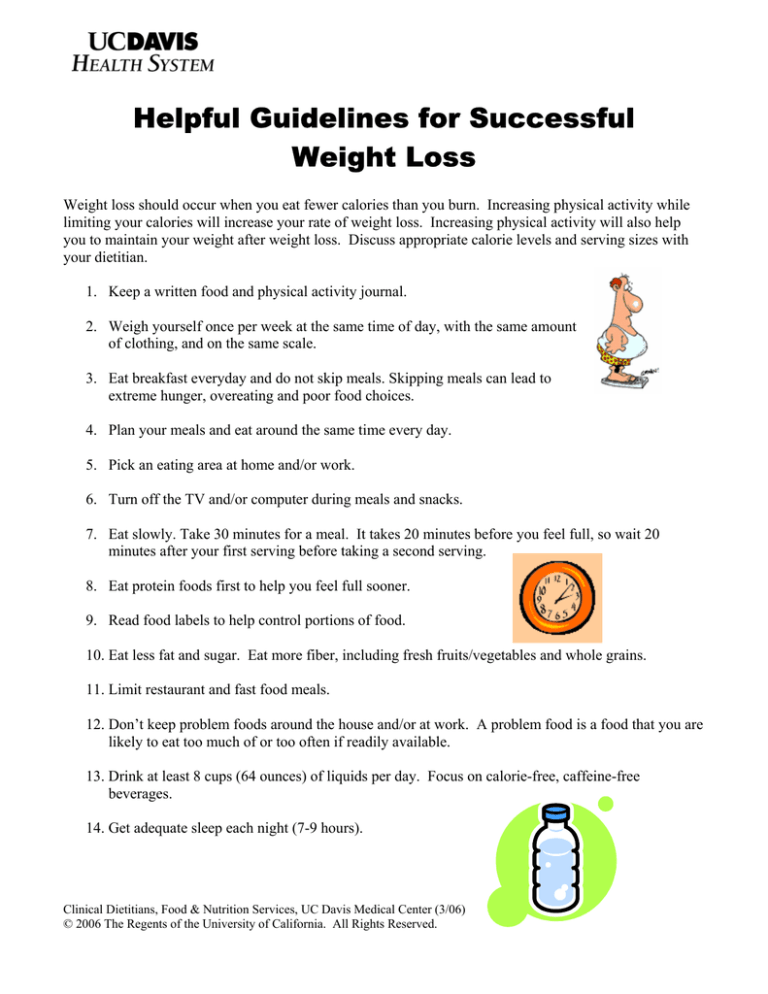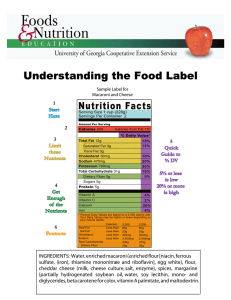Helpful Guidelines for Successful Weight Loss
advertisement

Helpful Guidelines for Successful Weight Loss Weight loss should occur when you eat fewer calories than you burn. Increasing physical activity while limiting your calories will increase your rate of weight loss. Increasing physical activity will also help you to maintain your weight after weight loss. Discuss appropriate calorie levels and serving sizes with your dietitian. 1. Keep a written food and physical activity journal. 2. Weigh yourself once per week at the same time of day, with the same amount of clothing, and on the same scale. 3. Eat breakfast everyday and do not skip meals. Skipping meals can lead to extreme hunger, overeating and poor food choices. 4. Plan your meals and eat around the same time every day. 5. Pick an eating area at home and/or work. 6. Turn off the TV and/or computer during meals and snacks. 7. Eat slowly. Take 30 minutes for a meal. It takes 20 minutes before you feel full, so wait 20 minutes after your first serving before taking a second serving. 8. Eat protein foods first to help you feel full sooner. 9. Read food labels to help control portions of food. 10. Eat less fat and sugar. Eat more fiber, including fresh fruits/vegetables and whole grains. 11. Limit restaurant and fast food meals. 12. Don’t keep problem foods around the house and/or at work. A problem food is a food that you are likely to eat too much of or too often if readily available. 13. Drink at least 8 cups (64 ounces) of liquids per day. Focus on calorie-free, caffeine-free beverages. 14. Get adequate sleep each night (7-9 hours). Clinical Dietitians, Food & Nutrition Services, UC Davis Medical Center (3/06) © 2006 The Regents of the University of California. All Rights Reserved. Food Preparation Use lowfat cooking methods such as baking, grilling, boiling, poaching, broiling, roasting, steaming or microwaving without additional fat. Avoid or limit frying. Place meat on a rack so the fat will drain off during cooking. Remove skin from poultry before cooking. Trim all visible fat from food (i.e. poultry and meat) before cooking. Use non-stick cookware or cooking sprays. Use egg whites or egg substitute in place of whole eggs. Season food with spices, butter flavoring (such as Butter Buds®), lemon or low-fat dressings. Limit high-fat sauces or gravies such as sour cream, regular salad dressings, full-fat gravy, and cream or cheese sauces (such as Hollandaise or Alfredo sauce). Use a sugar substitute in place of sugar. Replace sugar in recipes with a sugar substitute that can be used in baking or cooking. Restaurant Eating/Take-Out Limit appetizers, bread with butter, and chips. Select a salad with light dressing on the side or broth-based soup as your first course. Choose foods prepared using lowfat cooking methods. Request sauces, dressings, and gravies on the side. Place a portion of your meal in a take-home container before you start eating. Share an entrée with a friend. Consider purchasing a pocket-sized calorie counter book to help make healthy choices. Clinical Dietitians, Food & Nutrition Services, UC Davis Medical Center (3/06) © 2006 The Regents of the University of California. All Rights Reserved. 2 Food Groups and Recommended Portion Sizes Meat/Protein Bread/starch Fruit (2-3 servings per day) (4-8 servings per day) (2-4 servings per day) 1 serving = ½ cup rice/pasta/cereal; 1 slice bread; ½ small bagel 1 serving = 1 small piece fruit; ½ cup cut-up fruit; ½ cup fruit juice Choose more often Choose more often 1 serving = 3 ounces meat/poultry/fish; 1½ cups cooked dry beans/lentils/split peas; ½ cup tofu; 2 eggs Choose more often Poultry without skin Chili without meat Egg whites or egg substitute Baked fish Lean red meat (round, loin) Lowfat lunchmeat (<10% fat) Canned tuna in water Cooked dry beans/legumes Lentils Split peas/black eyed pea Tofu Tempeh Meat substitutes (soy based) Choose less often or avoid Bacon Sausage Hot dogs Fried chicken Poultry with skin Chili with meat Fried eggs Fried fish Fish sticks Marbled red meat Peanut butter Lunch meat, bologna, salami Nuts and seeds Canned tuna in oil Oil-packed sardines Barley Whole-grain bread Bulgur Unsweetened cereal Whole grain crackers English muffins Hominy Whole-grain pasta Brown rice Rice cakes Corn tortillas Plain popcorn Oatmeal Baked chips Choose less often or avoid Biscuits Chips Sweetened cereal Corn bread High fat crackers French toast Granola Pasta with cream sauce Macaroni and cheese Macaroni salad Muffins Pancakes Pizza Buttered popcorn Stuffing Crisp taco shells Waffles Clinical Dietitians, Food & Nutrition Services, UC Davis Medical Center (3/06) © 2006 The Regents of the University of California. All Rights Reserved. Fresh fruits Fruit canned in water or juice Frozen fruit without added sugar Unsweetened applesauce Choose less often or avoid Sweetened applesauce Fruit juice Fruit canned in syrup Fruit roll ups Fruit sorbet Avocado Coconut 3 Food Groups and Recommended Portion Sizes Vegetable Dairy/Milk (3 or more servings per day) (2-3 servings per day) 1 serving = ½ cup 1 serving = 8 ounces milk or yogurt; 1 ounce cheese; ¼ cup cottage cheese Choose more often Fresh, frozen or canned vegetables (Prepared without added fat) Broth-based vegetable soups Choose more often Nonfat or lowfat (1%) milk Nonfat or lowfat cheese Nonfat or lowfat cottage cheese Light nonfat fruit yogurt Nonfat or lowfat plain yogurt Choose less often or avoid Creamed vegetable soups French fries Fried or tempura vegetables Vegetables in cream sauce Hash brown potatoes Mashed potatoes made with butter Potato salad Choose less often or avoid Cheese Chocolate milk Ice cream / ice milk Whole or reduced fat 2% milk Pudding Regular fruit yogurt Frozen yogurt Fats (Use sparingly) 1 serving = 1 teaspoon butter or oil; 1 Tablespoon reduced-fat margarine/mayonnaise Bacon Grease Butter Cream Lard Margarine Mayonnaise Oil Salad Dressing Shortening Sour Cream Clinical Dietitians, Food & Nutrition Services, UC Davis Medical Center (3/06) © 2006 The Regents of the University of California. All Rights Reserved. 4 Empty Calorie Foods (These foods are high in fat and/or sugar, and low in nutrients) Doughnuts Shakes Beer Kool-Aid®/ Tang® Frosting Sherbet Candy Liquor Fruit-flavored drinks Marmalade Sodas Cake Fried foods Sweet rolls Chocolate Olives Gravy Sweet pickles Coconut Pastries Half and half Syrup Cookies Pies Honey Tartar sauce Cream Preserves Jam Whipped cream Cream cheese Popsicles Wine Cream sauce Salt pork Jell-O® Croissants Jelly Free Foods (Any food or drink that has 20 calories or less per serving) Mineral water Broth Coffee/Tea (regular or decaffeinated) Salsa Spices Diet soda Sugar-free gelatin Fat-free salad dressing Sugar-free syrup Fat-free mayonnaise Sugar substitutes Garlic Reduced-sugar or sugar-free jam or jelly Lemon Vinegar Lime Tips for Serving Sizes 3 oz meat, poultry or fish is approximately the size of a “deck of cards.” 1 oz of cheese is equivalent to 4 playing dice, 1 slice American cheese, or 1 mozzarella stick. 1 serving of fresh fruit is approximately the size of a tennis ball. 3 oz baked potato is approximately the size of a small computer mouse. Use measuring cups to measure both dry and liquid foods. This will help you learn what a serving size looks like on your plates, bowls, and glasses. Consider using smaller plates (for example, salad plates), bowls, and glasses to help control serving sizes. Use a food scale to measure cooked meats, nuts, and dry foods. Clinical Dietitians, Food & Nutrition Services, UC Davis Medical Center (3/06) © 2006 The Regents of the University of California. All Rights Reserved. Common Measurements 3 tsp = 1 Tbsp 4 oz = ½ cup 4 Tbsp = ¼ cup 8 oz = 1 cup 5⅓ Tbsp = ⅓ cup 1 cup = ½ pint 5 How to Read Food Labels Start here Serving size: The nutrition facts are for one serving Servings per container: Pay attention to how many servings you are eating. Limit calories, total fat, saturated fat, trans fat, cholesterol and sodium. % Daily Value is based on a 2,000 calorie diet. Discuss appropriate calorie levels with your dietitian. • 5% or less is low • 20% or more is high Choose foods that are high in dietary fiber, vitamin A, vitamin C, calcium and iron. Compare food labels for the lowest calories, fat, and sugar: Limit TOTAL FAT to 3 grams or less per serving Limit SUGAR to 5 grams or less per serving In milk and yogurt products, limit SUGAR to 12 grams or less per serving Choose starches with DIETARY FIBER 3 grams or more per serving Clinical Dietitians, Food & Nutrition Services, UC Davis Medical Center (3/06) © 2006 The Regents of the University of California. All Rights Reserved. 6 Tips to Become More Physically Active Consult your doctor before beginning any exercise routine. Begin slowly and work toward a goal of 30-90 minutes of moderate intensity activity most days of the week. Find activities you enjoy and spread physical activity throughout the day. Reward yourself for reaching your goals. Some examples are: • Buy yourself new sports equipment • Ask your spouse to take the kids for an hour • Visit a friend • Spend more time on your favorite hobby • Buy yourself some flowers or a plant • Enjoy a long hot bath If the weather is bad, have a backup plan. For example, take a walk in the local shopping mall. Wear comfortable and supportive shoes for walking. Leave your sneakers near the door to remind yourself to walk. Exercise before work. OR Bring a change of clothes to work and head straight for exercise on the way home. Schedule exercise on your calendar. Try to develop the habit of integrating more activity into your daily routine. • Take the stairs instead of the elevator • Park farther away from work or the store • Walk instead of driving to work or the store • Take one item up or down the stairs at a time instead of everything in one trip Vary your activity to avoid boredom. Listen to music while you exercise or exercise with a friend. Use a pedometer to keep track of your steps. Clinical Dietitians, Food & Nutrition Services, UC Davis Medical Center (3/06) © 2006 The Regents of the University of California. All Rights Reserved. 7 Weight Management Resources Books • • • • • • • • • • • Thin for Life: 10 Keys to Success from People Who Have Lost Weight and Kept It Off Anne Fletcher. Houghton Mifflin, revised and updated edition. 2003. ISBN 0618340556 Eating Thin for Life: Food Secrets and Recipes from People Who Have Lost Weight and Kept It Off Anne Fletcher. Houghton Mifflin. 1998. ISBN 1576300625 Habits Not Diets: The Secret to Lifetime Weight Control James Ferguson and Cassandra Ferguson. Bull Publishing. 4th edition. 2003. ISBN 0923521704 Breaking Free from Compulsive Eating Geneen Roth. Plume Books. 1993. ISBN 0452270847 The Healthy Weigh: A Practical Food Guide Maureen Callahan. American Dietetic Association. 1991. ISBN 0880910852 The American Dietetic Association’s Complete Food and Nutrition Guide Roberta Larson Duyff. Wiley, 2nd edition. 2002. ISBN 0471441449 The Calorie King’s Calorie, Fat and Carbohydrate Counter Alan Borushek. Family Health Publications. 2006. ISBN 1930448112 The Complete Cooking Light Cookbook Cathy Wesler, Editor. Oxmoor House. 2000. ISBN 084871945X The Essential Eating Well Cookbook: Good Carbs, Good Fats, Great Flavors Patsy Jamieson, Editor. Countryman, re-printed. 2006. ISBN 0881507016 The Eating Well Healthy in a Hurry Cookbook Jim Romanoff. Countryman. 2006. ISBN 088150877 The Step Diet: Count Steps, Not Calories to Lose Weight and Keep it off Forever James Hill, John Peters, Bonnie Jortberg, and Pamela Peeke. Workman Publishing Company, Bk & Acces edition. 2004. ISBN 0761133240 Internet Sites Take off Pounds Sensibly (TOPS): www.tops.org Overeaters Anonymous: www.overeatersanonymous.org Weight Watchers: www.weightwatchers.com Better Homes and Gardens Kitchen: www.bhg.com Betty Crocker: www.bettycrocker.com Vegetarian: www.vrg.org, www.fatfree.com Low fat recipes/Health: www.foodfit.com , www.lowfatlifestyle.com, www.recipesource.com American Dietetic Association: www.eatright.org American Heart Association: www.americanheart.org/ Nutritional Analysis from University of Illinois: www.ag.uiuc.edu/~food-lab/nat/ Nutrition Analysis Tools and System: http://nat.crgq.com Weight Loss: www.cyberdiet.com , www.shapeup.org, www.ediets.com Low Calorie: www.calorieking.com, www.cookinglight.com, www.eatingwell.com USDA Food Composition Data: www.ars.usda.gov/ba/bhnrc/ndl USDA Food Pyramid: www.mypyramid.gov National Weight Control Registry: www.lifespan.org/services/bmed/wt_loss/nwcr Clinical Dietitians, Food & Nutrition Services, UC Davis Medical Center (3/06) © 2006 The Regents of the University of California. All Rights Reserved. 8

